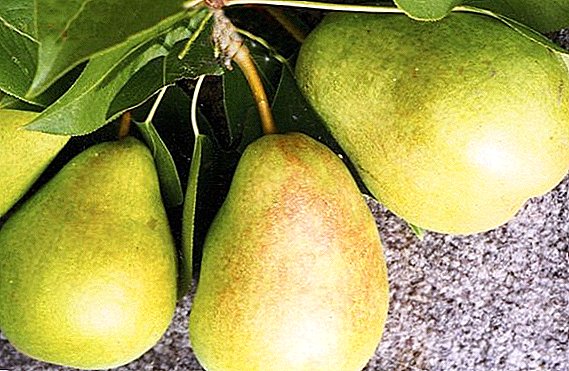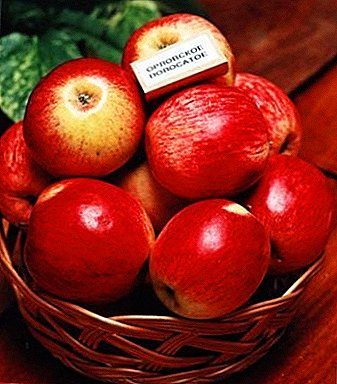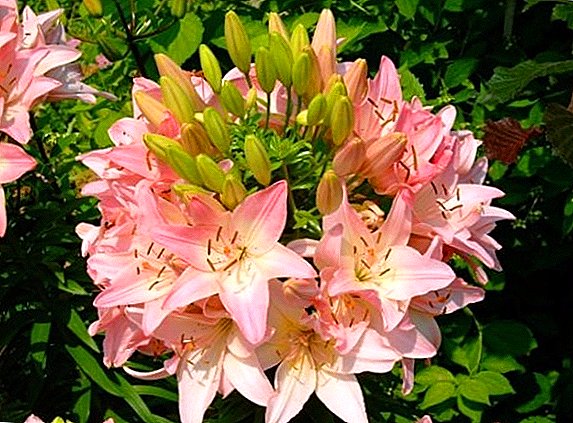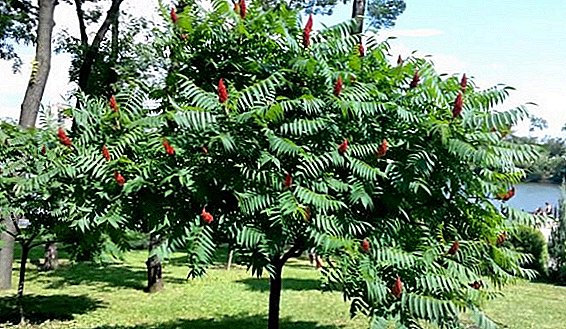 There are many beautiful trees.
There are many beautiful trees.
One of them is deer horn sumac, which will be a noticeable spot in your garden.
Let's see what kind of tree it is, how to care for it and how to decorate your garden.
How does it look
Fluffy sumac or deer horny, vinegar tree or as it is called in Latin, Rhus typhina is a member of the Sumach family, which grows mainly in the northeastern United States and in southeastern Canada. This deciduous tree grows up to 8 m in height.  In the Moscow region, the height of a deer horned sucker does not exceed 3 meters at the age of 4 years. The leaves are 6-11 cm in length, a pointed shape, notched at the edges, and a white color on the inside of the leaf. Each sheet is "assembled" on the branches in the "Commonwealth" from 9 to 31 sheets.
In the Moscow region, the height of a deer horned sucker does not exceed 3 meters at the age of 4 years. The leaves are 6-11 cm in length, a pointed shape, notched at the edges, and a white color on the inside of the leaf. Each sheet is "assembled" on the branches in the "Commonwealth" from 9 to 31 sheets.
Sumy blooms in early and mid summer. Flowers plantations are very beautiful, red-brown or light green. Each flower has stamens and a cone-like shape. The average length of a flower is 15 cm, diameter - about 5 cm.
Did you know? Sumy is used in Central Asia as a seasoning for meat dishes, instead of vinegar.In autumn, the leaves turn red and the tree turns red due to the color of the foliage, and after it falls off, fruits that have a pyramidal shape appear on the sumac. They are not interested in birds, which means you can admire them for a long time. Keep on the tree until next spring.
The tree grows up only the first years of life, then it grows in breadth. Sometimes planting resembles shrubs because of such a wide crown. 
How to endure winter and cold
Due to the fact that the natural habitat of the tree is the southern countries, our winters can transfer our winters with difficulty. But what is bad for planting is not at all bad for garden design.
The fact is that the old branches are frosting, but in their place new ones are formed, which helps the tree, with time, to become branchy, which means more beautiful and sweet look.
Ornamental maple, Tatar maple, catalpa, sakura, Nedzvetskogo apple tree, Norway holly, sycamore tree, red oak are also referred to as ornamental trees.Sumy can withstand winters to -30 ° C, but it needs to have more snow: it protects the tree from wind and freezing of the root system, otherwise the plant may die. Make sure that the snow enveloped not only the crown of the plantation, but also all the space around it.
To protect the winter, the snow depth should be about half a meter. In the fall, it is necessary to sprinkle the tree trunks with leaves to make it easier for plants to winter. Additionally, peat or hay will help to shelter a tree from frost.  Another confirmation that sumah has adapted to our winters is the presence of red fruits on the "female" plants, which remain on the tree until spring.
Another confirmation that sumah has adapted to our winters is the presence of red fruits on the "female" plants, which remain on the tree until spring.
Landscaping Applications and Neighbors
This plant is often chosen for Japanese gardens. In addition, it harmonizes well with coniferous horizontal crowns and gets along well with plants with blue needles. Another company for the vinegar tree is perennials: they look very beautiful with sumach in the autumn.
You can use the plant and as part of the stony gardens. The very vinegar tree is very unpretentious.
When engaged in planting, designers pay attention to its features such as: the possibility of good securing of slopes and ravines and frequent use for removing weeds, since this planting grows very quickly and does not give harmful plants space for development.  Vinegar is planted along the fence or as a hedge.
Vinegar is planted along the fence or as a hedge.
The only problem associated with this plant may be the ability to grow sumach, because it "swallows" not only pest plants, but also all benign plantings.
Did you know? The vinegar tree lives about 15-20 years and dies. But it is being revived again due to new shoots emerging from the root of the plant.
How to choose seedlings when buying
It is best to buy seedlings in proven nurseries: there they are accurately taken care of. Before buying, you need to carefully consider a small plant. The seedling should be symmetrical, with normally developed leaves. If it is somewhat crooked, it means that it was cut off.
Rhizome should be well formed and developed. If the root is damaged, the plant will soon die. It is better to be offered a com formed from the native soil: so you will know that the root system is fine.  Next, look at the leaves. They should not be faded and lifeless. Good seedlings always have elastic leaves that should not be dried ends. Also, there should be no mold and cobwebs: this indicates a disease of a planting or the presence of harmful insects.
Next, look at the leaves. They should not be faded and lifeless. Good seedlings always have elastic leaves that should not be dried ends. Also, there should be no mold and cobwebs: this indicates a disease of a planting or the presence of harmful insects.
A good copy of the root system without rot and spots. The elastic roots should be well buried in the ground. If the plant has too large flowers or an unnaturally green color, it means that it is too overfed with nutrient compounds.
You should not buy it, as it will hurt and may die before your eyes. Now, when we figured out how to choose a plant, let's figure out how to plant it.
Choosing a landing site
Having figured out exactly what conditions are needed for the vinegar tree, in the future this knowledge will help you choose the most suitable site for it. 
Lighting
Sumy likes a lot of light. He can live in the shade, but with very good lighting - the development will take place better and faster. So do not plant it near the house and the shed: it is better to plant in the middle of the garden, without enclosing anything anywhere.
This will help in the event that (and will be) the plant grows. The fact is that it is much easier to pull out young trees that you do not need in an open area than in the vicinity of young apple trees or pears.
Important! Try to choose an area where there are no constant cold winds, because this green pet does not tolerate drafts.
The soil
The tree grows on sandy, sandy-argillaceous and sandy-stony ground. The vinegar tree likes friable dry soils. He does not like waterlogging and does not tolerate close proximity to groundwater, a strong density of the earth. Does not like a plant of wet and medium wet drained soil types.  However, calmly transfers the average salinity of the substrate. Can sumac grow on stone limestone. The roots of the plant cling well even to the soil of a ravine or scree.
However, calmly transfers the average salinity of the substrate. Can sumac grow on stone limestone. The roots of the plant cling well even to the soil of a ravine or scree.
Planting seedlings on the site: the process and scheme
To plant seedlings of deer-horned sumach should be in spring or autumn, when the plant will be two or three years old. In the autumn, the seedlings are planted in a container so that they can be transplanted into permanent soil in the spring. It is necessary to plant both female and male plants.
The process of planting begins with digging a hole for the root. It should correspond to the earthworks. The excavated earth should be mixed with a compost spade.
Straighten the roots of the plant and plant in the ground so that the earthy ball was on a par with the surface of the soil. Next, fill the pit and pour the planting.
The distance between the two vinegar trees should not be less than two and a half meters. During planting, dig in the root growth stops deeper.  This can be a board, slate or metal sheets: sumac grows very quickly throughout the garden, which is not always pleasant for the gardener.
This can be a board, slate or metal sheets: sumac grows very quickly throughout the garden, which is not always pleasant for the gardener.
Three days after planting, it is necessary to mulch the soil around the plant and water it abundantly. It is best to mulch with sawdust and peat.
Important! The mulch layer must be at least 5 cm.
Care Tips
We figured out how to plant deer horned sumach, now let's look at how to care for them.
Watering and feeding
Caring for this plant is simple. It is necessary to mulch the land immediately after planting, using wood chips or sawdust, a layer of 6 cm. Watering is done only in dry weather. If the plant is already an adult, then it does not need to be watered at all.
In the beginning of the spring, nitroammofosca is applied: 30 grams of fertilizer are needed per 1 m². 
Pruning
In winter, many branches of planting die off, because they do not withstand severe frosts, which means that in the spring it is necessary to prune. Only dead and dry branches are cut.
It is also necessary to prune the branches if you do not want the tree to grow upwards: the plant looks much more interesting and attractive with a wide crown. During pruning, the tree produces a thick yellowish sap that eventually solidifies and turns black.
Learn about the rules for pruning trees, especially peaches, plums, cherries, cherries, pears, and apple trees.
Diseases and pests
Vinegar tree, most often, suffers from fungal diseases. We will not consider all of them, but dwell on the two most common ones: powdery mildew and drying of branches and shoots. Fungi can be transported both by air and on / in the ground.  So powdery mildew. Initially, the disease is noticeable as a kind of white cobweb on the leaves of a tree, but over time it turns into a patina. This bloom quickly spreads to neighboring leaves and quickly captures the entire tree.
So powdery mildew. Initially, the disease is noticeable as a kind of white cobweb on the leaves of a tree, but over time it turns into a patina. This bloom quickly spreads to neighboring leaves and quickly captures the entire tree.
The longer the plant is not treated for this disease, the greater the chance that the vinegar tree will die. Most often, the plant has a mealy race in warm weather and high humidity. Also contributes to this disease and a large amount of nitrogen fertilizer or nitrogen in the soil as a whole.
To avoid this disease, it is necessary to weed around the plant (in the event of their occurrence), to loosen the soil around the plantings, and not to plant trees too close to one another. If one shoot does get sick, you have to destroy it, otherwise all plantations will die.
There are also folk remedies by which powdery mildew is destroyed, but they are better used to prevent the disease or are used in its early stages. If the disease has long suma suma - use chemicals.  Shrinking shoots and branches. This disease, the planting is subject to damage to the bark. It begins with the cracking of the bark, then dry the branches. Dead branches have mycelium - the formation of black, light pink or brown.
Shrinking shoots and branches. This disease, the planting is subject to damage to the bark. It begins with the cracking of the bark, then dry the branches. Dead branches have mycelium - the formation of black, light pink or brown.
Prevention of this disease consists in tracking and treating the bark and the main branches of the tree. If the branch is sick, it must be cut and burned. Also used chemicals for the treatment of this disease. The plant does not actually suffer from pests.
In general, sumac is a beautiful bright tree that will please your eye for many years, you just have to make a little effort and provide it with comfortable living conditions.












